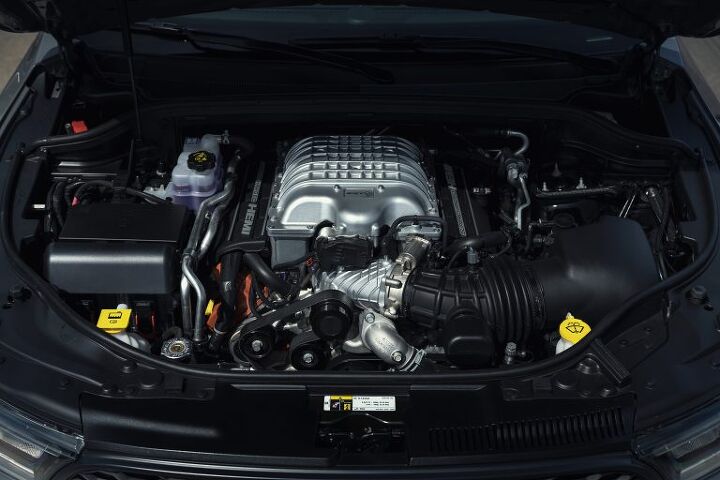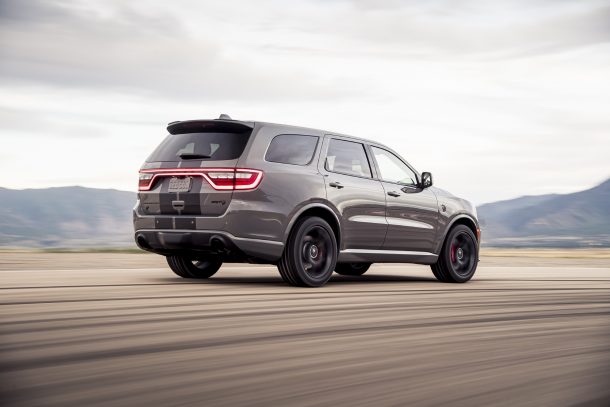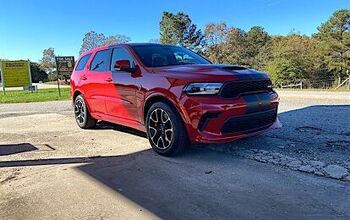One Year Only: Dodge Durango SRT Hellcat

Dodge continues to parade its buffet of power ahead of the July 4th weekend, announcing the most aggressive versions of its coupe, sedan, and SUV. While the 2021 Dodge Durango lineup happens to be last we’ll cover, we wouldn’t consider it the least important — especially in regard to sales. Most transactions will come via the standard Durango model, which receives a number of exterior enhancements and sweeping upgrades to its interior.
But it wouldn’t have been right for FCA to just leave us with a better SUV after showing us what could be done with the Challenger and Charger. So it crammed the Hellcat’s 6.2-liter V8 inside the Durango before calling it a day, satisfied that it had finally done enough for enthusiasts before emissions regulations manage to ruin their lives forever.
Despite your author’s personal taste for lower ride heights, the Durango SRT Hellcat seems a wise conclusion on the part of Fiat Chrysler. The New Jersey Turnpike has thrice presented me with a Jeep Grand Cherokee Trackhawk being piloted confidently through traffic. Either New Jersey has a sick obsession with ludicrously powered utility vehicles or there’s actually a market for this kind of automobile. Sadly, Dodge tells us it’s only available for the 2021 model year — after which it will no longer be emissions compliant for the segment.
Ah, progress.
But what are you really getting while the getting is presumably good? Quite a lot, actually. The Durango Hellcat makes the Ford Edge ST look like a baby’s toy by comparison. Its supercharged V8 makes a whopping 710 horsepower and 645 lb-ft of torque and sends it to all four corners of the vehicle via a Torqueflite 8HP95 8-speed automatic (same as Jeep’s Trackhawk).
That promises an exciting 0-60 time of just 3.5 seconds and quarter-mile runs of around 11.5 seconds. Speed hunters may find themselves gravitating toward the Charger Redeye we discussed earlier in the day, but anyone with more than a couple of kids will welcome the Durango’s superior interior volume and practicality. The SUV still goes 180 mph and will dust just about anything else that sidles up to you at a stoplight.
It’ll be a contender even if you’re hauling cargo, as it possesses a towing capacity of 8,700 pounds, though we cannot begin to imagine how that will impact fuel economy.
However, the Durango has made a few sacrifices in the name of performance. For one, Dodge nixed the fog lamps in favor of two cold-air intakes. The passenger side sucks air directly into the intake manifold while the driver’s side pulls it in for an upgraded oil cooler. Speaking of airflow, the SRT Hellcat also boasts the largest x-pipe Dodge could muster — claiming that it gives the model a truly distinct sound.
Aerodynamics have also been given a lot of attention. SRT fitted the Hellcat SUV with a functional chin spoiler, new front and rear fascias, and a rear spoiler that generates 140 pounds of downforce at top speed. While Dodge admits it was added to help with stability, engineers confessed it was mostly there to round out the aesthetics. They also recommend against trying to hit 180 mph on public roads.
Brakes and tires carry over from the 475-hp SRT Durango, though customers can opt for a set of 20-inch wheels and stickier tires as part of the black pack — which darkens trim pieces for that murdered-out look. Though even without the appearance pack it’s a more sinister-looking automobile. Dodge says all of the exterior changes were either done in service of improving performance or making it more closely resemble the Charger.
It also promises a more comfortable experience when you want it. Thanks to tuned internal rebound springs, coupled with a matched upper top mount, Dodge says the dynamic tuning range has been increased. That means setting the car in comfort mode should be more comfortable. Meanwhile, Dodge has added stiffness and reduced body roll in track mode — resulting in a more responsive turn-in with 2.5 percent less understeer at the limit.
The entire Durango line adopts an improved interior with Uconnect 5 and an optional 10.1-inch infotainment screen. We’ve very little bad to say about Uconnect lately (and have reviewed version 5 in the past). We primarily like it because it’s one of the most intuitive interfaces in the industry and forsakes gimmicky displays for superior functionality and customizability. The interior also has a more diver-focused orientation overall, with the manufacturer again taking cues from the Charger/Challenger.
Durango Hellcat models will also offer unique red accenting, specialty SRT touches and standard heated/ventilated seats with leather and Alcantara trim. But even more luxurious/gaudy red ones are available if you’re not a fan of understated interiors.
As with the Charger SRT Hellcat Redeye, Dodge will begin taking orders of the Durango SRT Hellcat in the fall. Showrooms should start seeing them in early 2021. If you want one, you’d best act early. As previously mentioned, FCA said it can only build these babies for one year before they’re technically illegal.

A staunch consumer advocate tracking industry trends and regulation. Before joining TTAC, Matt spent a decade working for marketing and research firms based in NYC. Clients included several of the world’s largest automakers, global tire brands, and aftermarket part suppliers. Dissatisfied with the corporate world and resentful of having to wear suits everyday, he pivoted to writing about cars. Since then, that man has become an ardent supporter of the right-to-repair movement, been interviewed on the auto industry by national radio broadcasts, driven more rental cars than anyone ever should, participated in amateur rallying events, and received the requisite minimum training as sanctioned by the SCCA. Handy with a wrench, Matt grew up surrounded by Detroit auto workers and managed to get a pizza delivery job before he was legally eligible. He later found himself driving box trucks through Manhattan, guaranteeing future sympathy for actual truckers. He continues to conduct research pertaining to the automotive sector as an independent contractor and has since moved back to his native Michigan, closer to where the cars are born. A contrarian, Matt claims to prefer understeer — stating that front and all-wheel drive vehicles cater best to his driving style.
More by Matt Posky
Latest Car Reviews
Read moreLatest Product Reviews
Read moreRecent Comments
- Bouzouki Cadillac (aka GM!!) made so many mistakes over the past 40 years, right up to today, one could make a MBA course of it. Others have alluded to them, there is not enough room for me to recite them in a flowing, cohesive manner.Cadillac today is literally a tarted-up Chevrolet. They are nice cars, and the "aura" of the Cadillac name still works on several (mostly female) consumers who are not car enthusiasts.The CT4 and CT5 offer superlative ride and handling, and even performance--but, it is wrapped in sheet metal that (at least I think) looks awful, with (still) sub-par interiors. They are niche cars. They are the last gasp of the Alpha platform--which I have been told by people close to it, was meant to be a Pontiac "BMW 3-series". The bankruptcy killed Pontiac, but the Alpha had been mostly engineered, so it was "Cadillac-ized" with the new "edgy" CTS styling.Most Cadillacs sold are crossovers. The most profitable "Cadillac" is the Escalade (note that GM never jack up the name on THAT!).The question posed here is rather irrelevant. NO ONE has "a blank check", because GM (any company or corporation) does not have bottomless resources.Better styling, and superlative "performance" (by that, I mean being among the best in noise, harshness, handling, performance, reliablity, quality) would cost a lot of money.Post-bankruptcy GM actually tried. No one here mentioned GM's effort to do just that: the "Omega" platform, aka CT6.The (horribly misnamed) CT6 was actually a credible Mercedes/Lexus competitor. I'm sure it cost GM a fortune to develop (the platform was unique, not shared with any other car. The top-of-the-line ORIGINAL Blackwing V8 was also unique, expensive, and ultimately...very few were sold. All of this is a LOT of money).I used to know the sales numbers, and my sense was the CT6 sold about HALF the units GM projected. More importantly, it sold about half to two thirds the volume of the S-Class (which cost a lot more in 201x)Many of your fixed cost are predicated on volume. One way to improve your business case (if the right people want to get the Green Light) is to inflate your projected volumes. This lowers the unit cost for seats, mufflers, control arms, etc, and makes the vehicle more profitable--on paper.Suppliers tool up to make the number of parts the carmaker projects. However, if the volume is less than expected, the automaker has to make up the difference.So, unfortunately, not only was the CT6 an expensive car to build, but Cadillac's weak "brand equity" limited how much GM could charge (and these were still pricey cars in 2016-18, a "base" car was ).Other than the name, the "Omega" could have marked the starting point for Cadillac to once again be the standard of the world. Other than the awful name (Fleetwood, Elegante, Paramount, even ParAMOUR would be better), and offering the basest car with a FOUR cylinder turbo on the base car (incredibly moronic!), it was very good car and a CREDIBLE Mercedes S-Class/Lexus LS400 alternative. While I cannot know if the novel aluminum body was worth the cost (very expensive and complex to build), the bragging rights were legit--a LARGE car that was lighter, but had good body rigidity. No surprise, the interior was not the best, but the gap with the big boys was as close as GM has done in the luxury sphere.Mary Barra decided that profits today and tomorrow were more important than gambling on profits in 2025 and later. Having sunk a TON of money, and even done a mid-cycle enhancement, complete with the new Blackwing engine (which copied BMW with the twin turbos nestled in the "V"!), in fall 2018 GM announced it was discontinuing the car, and closing the assembly plant it was built in. (And so you know, building different platforms on the same line is very challenging and considerably less efficient in terms of capital and labor costs than the same platform, or better yet, the same model).So now, GM is anticipating that, as the car market "goes electric" (if you can call it that--more like the Federal Government and EU and even China PUSHING electric cars), they can make electric Cadillacs that are "prestige". The Cadillac Celestique is the opening salvo--$340,000. We will see how it works out.
- Lynn Joiner Lynn JoinerJust put 2,000 miles on a Chevy Malibu rental from Budget, touring around AZ, UT, CO for a month. Ran fine, no problems at all, little 1.7L 4-cylinder just sipped fuel, and the trunk held our large suitcases easily. Yeah, I hated looking up at all the huge FWD trucks blowing by, but the Malibu easily kept up on the 80 mph Interstate in Utah. I expect a new one would be about a third the cost of the big guys. It won't tow your horse trailer, but it'll get you to the store. Why kill it?
- Lynn Joiner Just put 2,000 miles on a Chevy Malibu rental from Budget, touring around AZ, UT, CO for a month. Ran fine, no problems at all, little 1.7L 4-cylinder just sipped fuel, and the trunk held our large suitcases easily. Yeah, I hated looking up at all the huge FWD trucks blowing by, but the Malibu easily kept up on the 80 mph Interstate in Utah. I expect a new one would be about a third the cost of the big guys. It won't tow your horse trailer, but it'll get you to the store. Why kill it?
- Ollicat I am only speaking from my own perspective so no need to bash me if you disagree. I already know half or more of you will disagree with me. But I think the traditional upscale Cadillac buyer has traditionally been more conservative in their political position. My suggestion is to make Cadillac separate from GM and make them into a COMPANY, not just cars. And made the company different from all other car companies by promoting conservative causes and messaging. They need to build up a whole aura about the company and appeal to a large group of people that are really kind of sick of the left and sending their money that direction. But yes, I also agree about many of your suggestions above about the cars too. No EVs. But at this point, what has Cadillac got to lose by separating from GM completely and appealing to people with money who want to show everyone that they aren't buying the leftist Kook-Aid.
- Jkross22 Cadillac's brand is damaged for the mass market. Why would someone pay top dollar for what they know is a tarted up Chevy? That's how non-car people see this.








































Comments
Join the conversation
Anyone who hates on this monster is not a true car person. The Durango Hellcat is absolutely fantastic and ticks about every box anyone could ever want. I love it and would consider it if I ran into a few bucks. I adore the Durango SRT, the Hellcat would be that much better!
I wish these came out earlier!